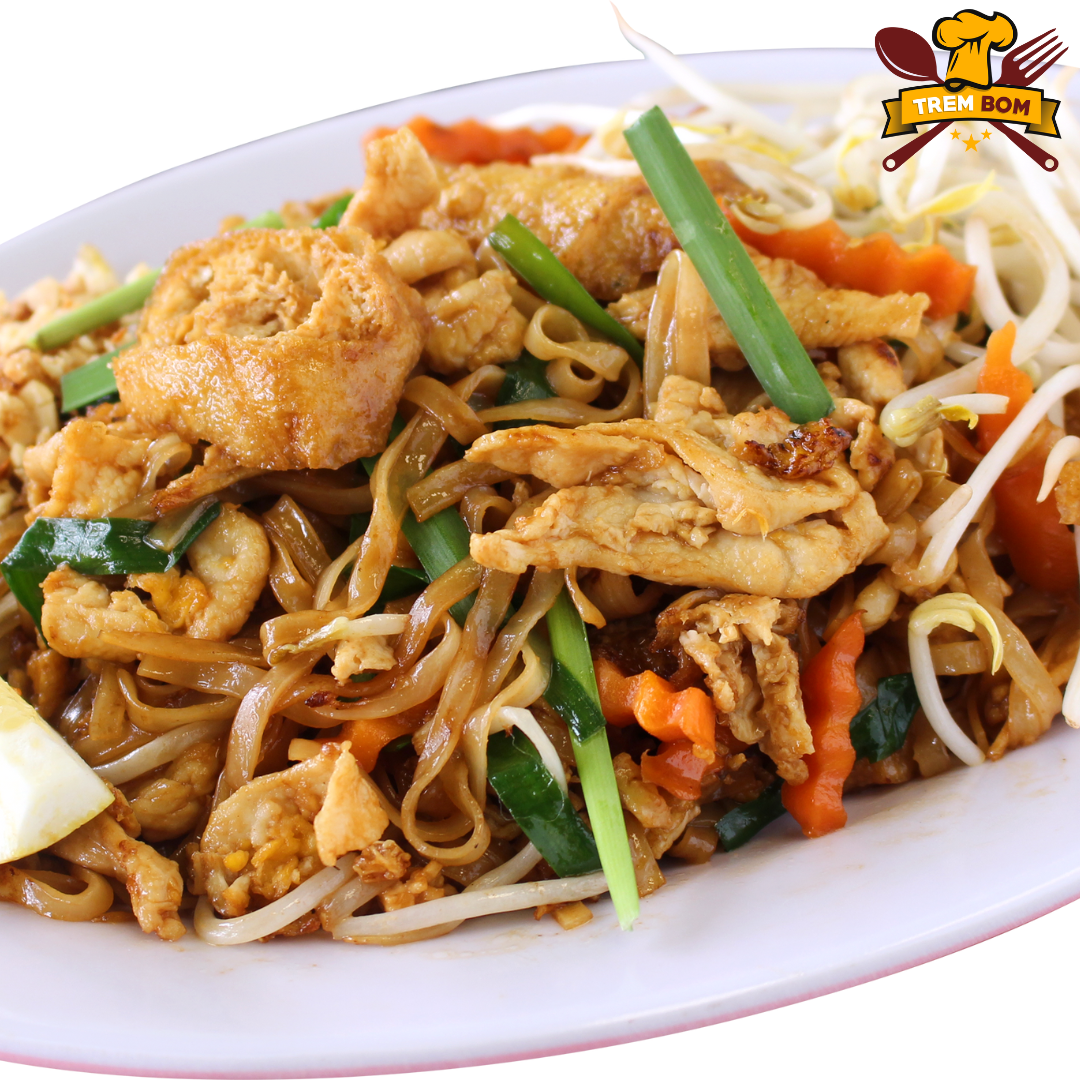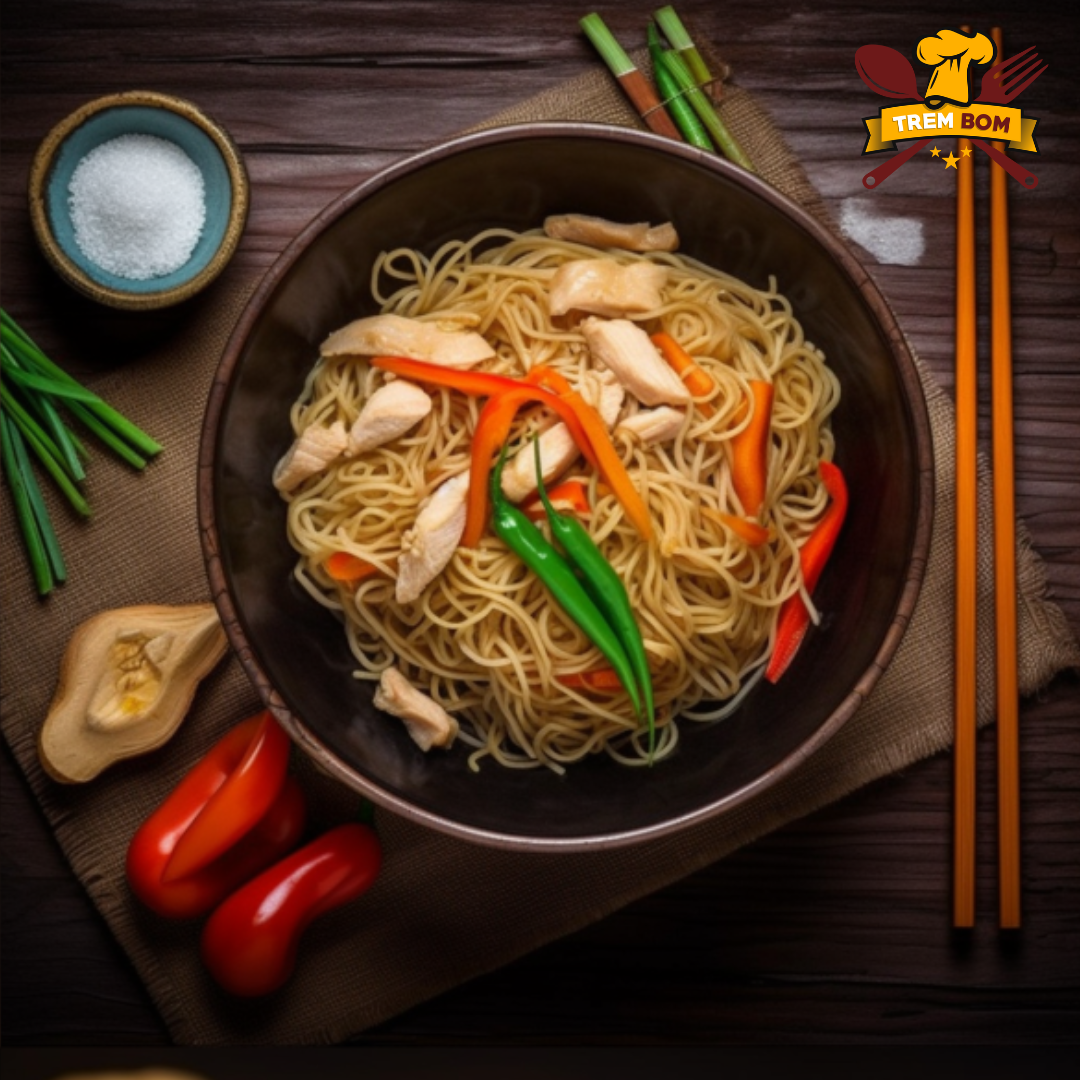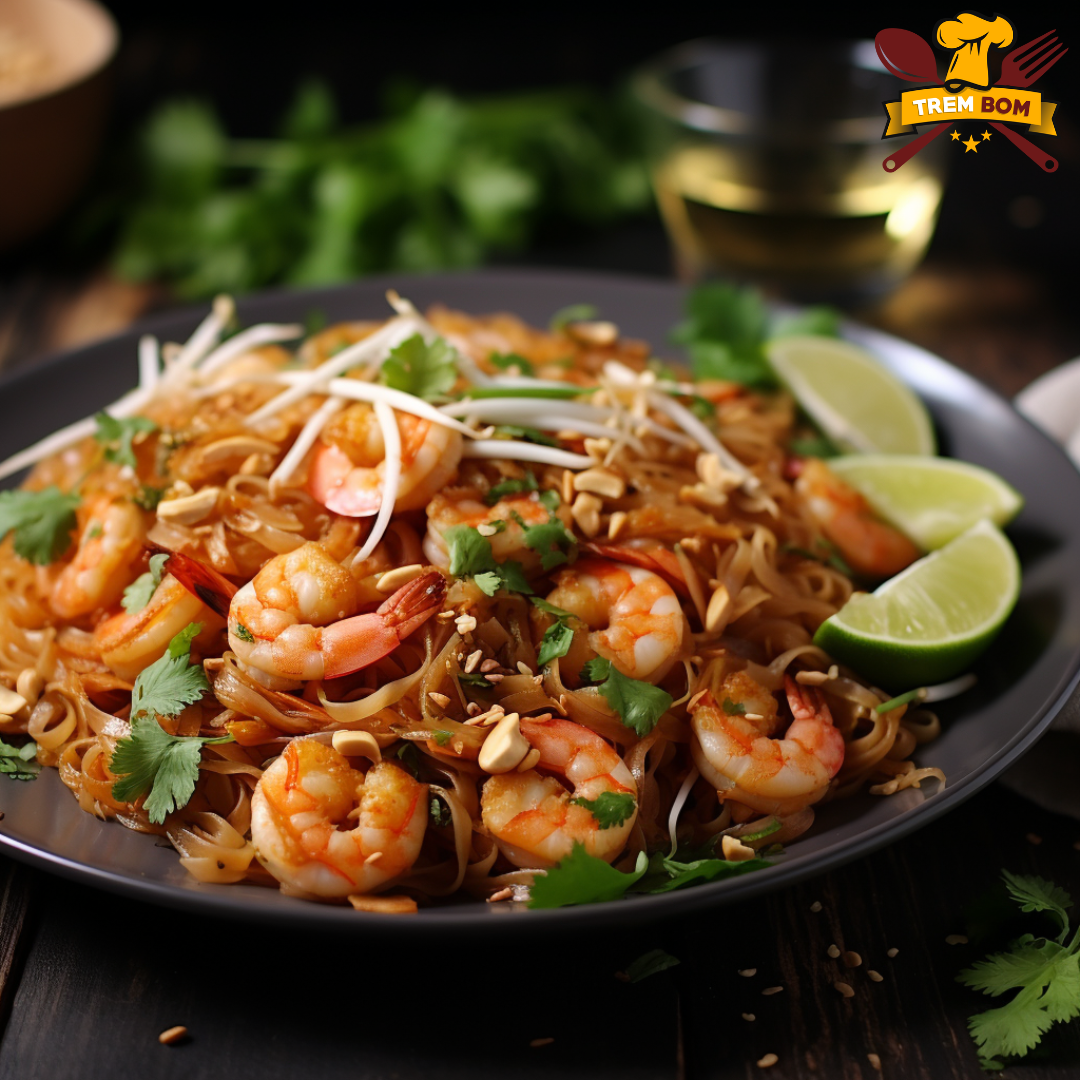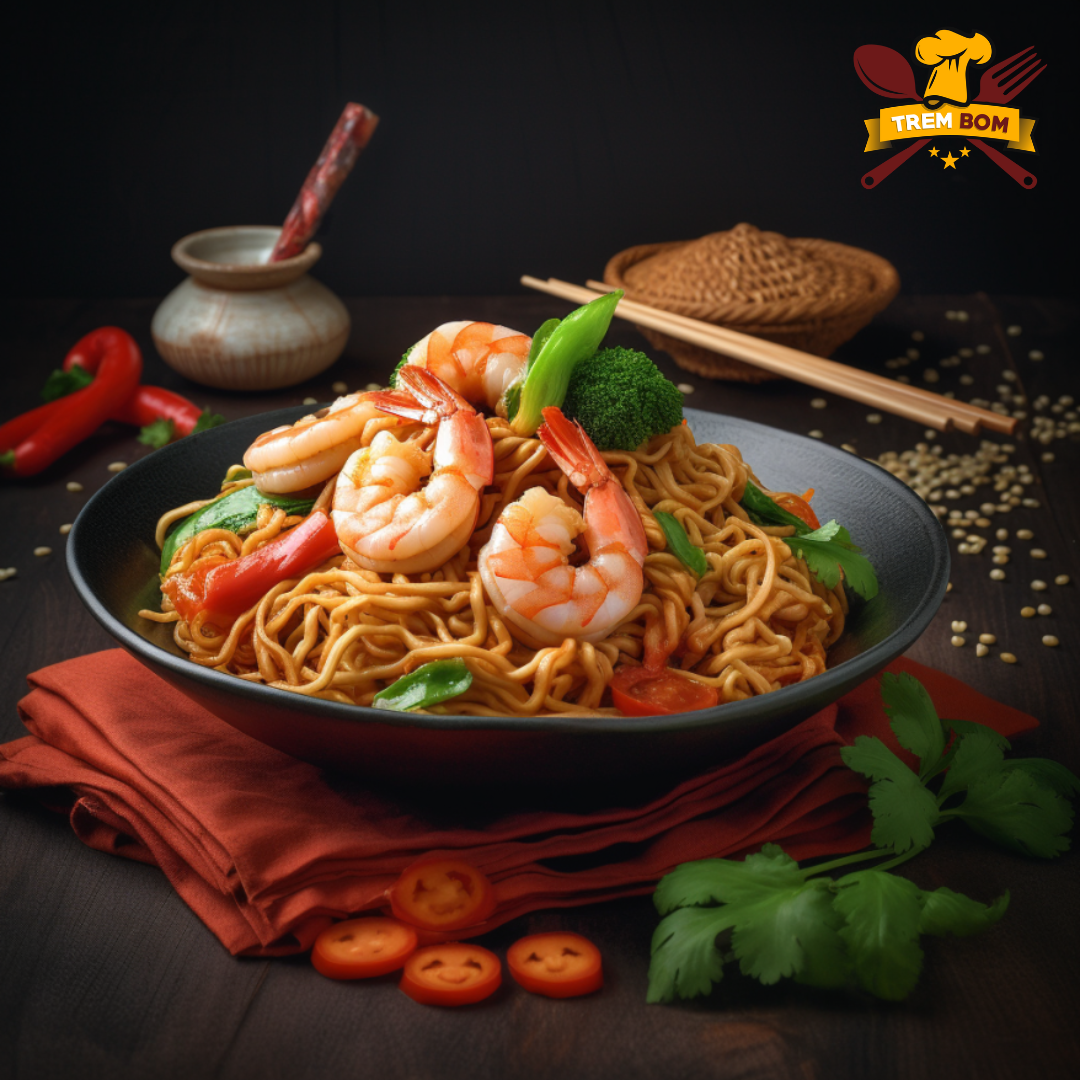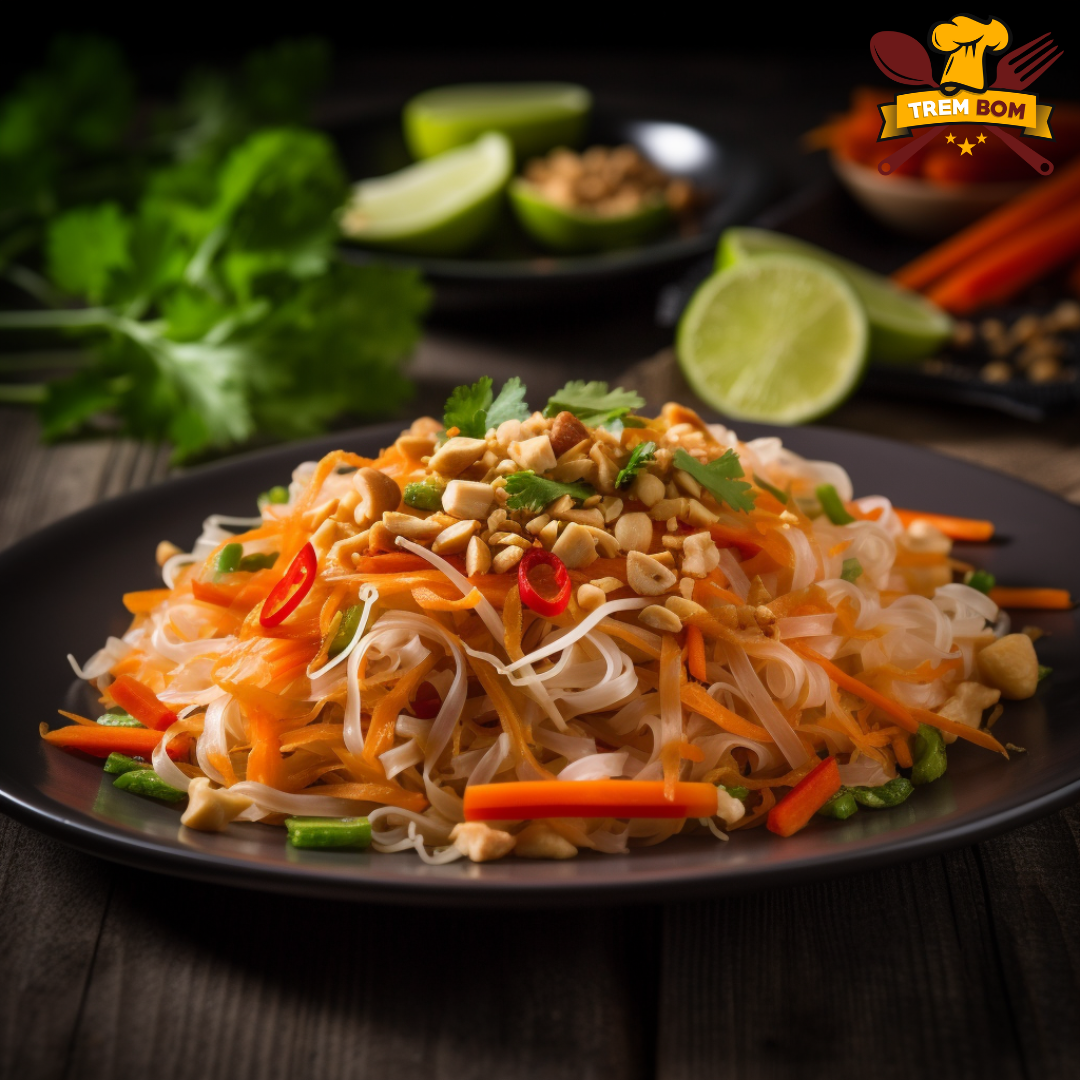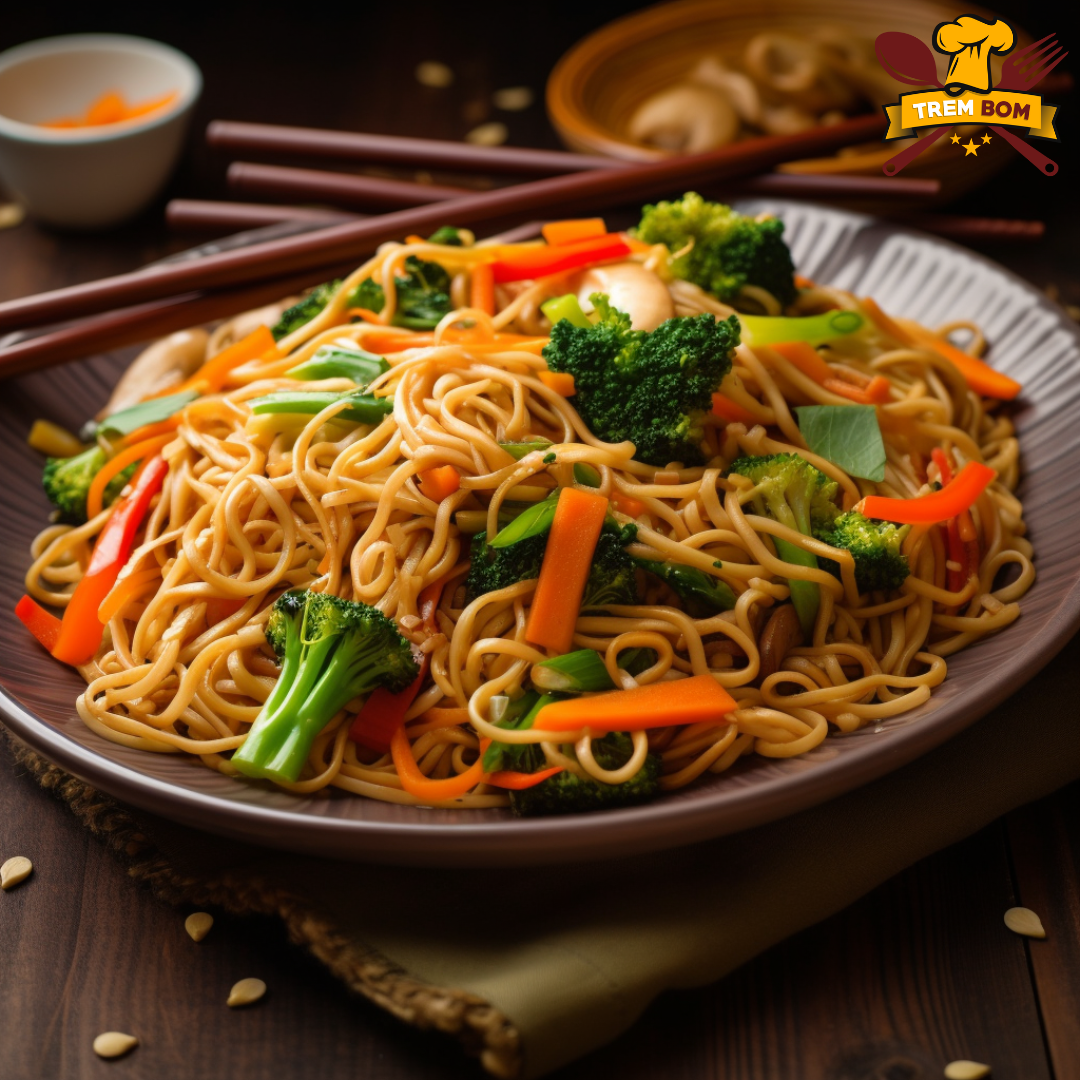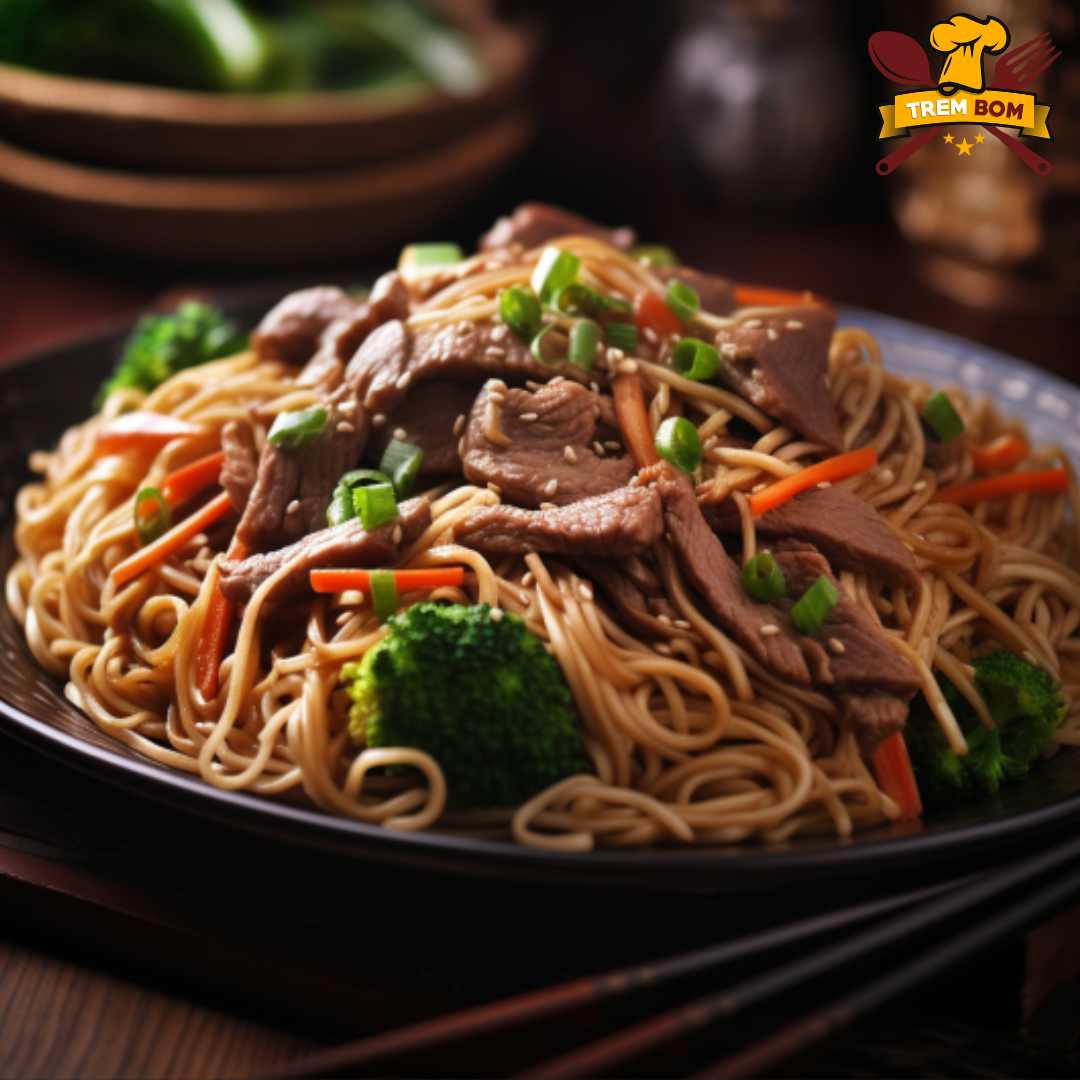Key Takeaways:
- Pad Thai and Lo Mein are both popular noodle dishes from different cuisines – Pad Thai is from Thailand and Lo Mein is from China.
- Lo Mein typically uses wheat noodles, while Pad Thai traditionally uses rice noodles, resulting in different textures and mouthfeel.
- The flavors of Pad Thai and Lo Mein differ significantly – Pad Thai is known for its combination of sweet, sour, and spicy flavors, while Lo Mein has a savory umami flavor with a balance of soy sauce and other seasonings.
- Nutritionally, Lo Mein tends to be higher in calories and fat compared to Pad Thai. However, both dishes can be customized to meet individual dietary preferences and restrictions.
- When choosing between Pad Thai and Lo Mein, consider personal preferences, cultural influences, and the occasion. Pad Thai is a great choice for those who enjoy bold and vibrant flavors, while Lo Mein offers a comforting and satisfying taste.
- Both Pad Thai and Lo Mein have their own unique characteristics and are worth trying. Embrace the diversity of flavors and embark on a flavorful adventure by enjoying these delicious noodle dishes.
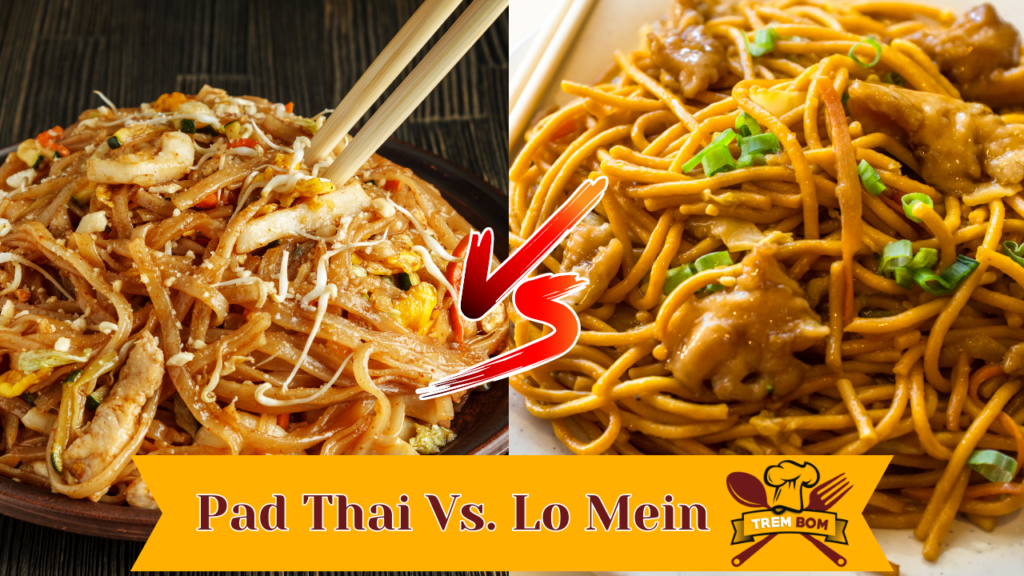
Introduction to Pad Thai and Lo Mein
When it comes to exploring the delectable world of Asian cuisine, two dishes that often steal the spotlight are Pad Thai and Lo Mein. As a food enthusiast, I’ve found myself in numerous debates over which of these mouthwatering options reigns supreme. The difference between these two noodle dishes comes down to preference. Some people enjoy the texture of pad thai noodles while lo mein is often preferred by others.
In this section, we’ll delve into the flavors, ingredients, and cultural backgrounds that set the stage for a captivating comparison between Pad Thai and Lo Mein. Prepare your taste buds as we embark on a culinary journey to uncover the nuances and delights of these beloved dishes.
Setting the stage for the comparison between Pad Thai and Lo Mein Noodles
To set the stage for comparing Pad Thai and Lo Mein, it is important to understand the unique aspects of each dish. This includes considering their origins, key ingredients, and flavor profiles. By exploring these factors, we can make an informed comparison between these two popular noodle dishes.
In order to compare Pad Thai and Lo Mein effectively, let’s create a table that highlights their distinguishing features:
| DISH | ORIGIN | KEY INGREDIENTS | FLAVOR PROFILE |
|---|---|---|---|
| Pad Thai | Thailand | Rice noodles, tofu or shrimp | Sweet, tangy, and savory with hints of tamarind |
| Lo Mein | China | Wheat noodles, vegetables | Savory and slightly salty with a nice chewiness |
By examining this table, we can see that Pad Thai originates from Thailand and typically includes rice noodles as the base ingredient. It is known for its distinct sweet and tangy flavor profile that comes from the use of tamarind paste. On the other hand, Lo Mein is a Chinese dish made with wheat noodles and various vegetables. Its flavor profile is more on the savory side with a slight saltiness to enhance the taste.
Now that we have established the unique features of each dish, let’s consider how personal preferences and cultural influences may affect one’s choice between Pad Thai and Lo Mein. Some individuals may prefer the bold flavors of Pad Thai and be drawn to its exotic Thai cuisine roots. Others may lean towards Lo Mein for its heartier texture and more familiar Chinese flavors.
Overall, when choosing between Pad Thai and Lo Mein, it’s essential to consider your individual taste preferences as well as any dietary restrictions or allergies you may have. Both dishes offer a delightful combination of flavors and textures that can satisfy a wide range of culinary cravings. So why not embark on a flavorful adventure by trying both dishes?
Prepare to unravel the savory secrets of Lo Mein, a Chinese dish that will leave your taste buds in a state of noodle nirvana.
Understanding Lo Mein Noodles
When it comes to delicious Chinese dishes, one that often stands out is Lo Mein. This versatile noodle dish offers a range of flavors and ingredients that tantalize the taste buds. From its cultural significance to the common ingredients used, we’ll be diving deep into understanding Lo Mein. Discover the rich history and origins of this beloved Chinese dish, along with the key ingredients and seasonings that give it its distinct taste. Join me on this flavorful journey as we explore the diverse and appetizing flavor profile of Lo Mein.
Description of Lo Mein as a Chinese dish
Lo Mein is a Chinese noodle which is characterized by its unique noodle preparation. Made from wheat flour, these long, thin noodles are mixed with various ingredients like vegetables, meat, and seafood to create a delectable dish. The noodles are typically stir-fried until they reach the perfect texture – chewy yet tender. Additionally, Lo Mein is known for its savory flavor profile that combines the umami taste of soy sauce with hints of garlic and ginger. These distinct qualities make Lo Mein a quintessentially Chinese dish enjoyed by people all over the world.
As a traditional Chinese dish, Lo Mein stands out due to its distinct characteristics. Unlike other noodle dishes such as Chow Mein or Dan Dan Noodles, which may be served in broth or have different toppings, Lo Mein features stir-fried noodles as its main component. This cooking method allows the flavors to meld together while retaining the springy texture of the noodles. In addition to being stir-fried, another notable aspect of this dish is the range of ingredients that can be incorporated into it. From succulent slices of pork or chicken to an assortment of fresh vegetables like bok choy and mushrooms, Lo Mein offers endless possibilities for customization.
One interesting aspect worth noting is that despite being a popular Chinese dish, Lo Mein has also been adapted and embraced by other cultures around the world. It has become a staple in many Asian fusion restaurants and has gained popularity among Western audiences as well. Its versatility makes it an ideal choice for those seeking a satisfying and flavorful meal.
To fully appreciate the experience of indulging in Lo Mein as a Chinese delicacy, it is recommended to savor it at authentic Chinese establishments where chefs use traditional recipes and techniques passed down through generations. This ensures that every bite captures the essence of this beloved cuisine. Additionally, exploring different regional variations within China itself can provide valuable insights into how flavors and ingredients may vary across different provinces.
Unleash your taste buds with a savory symphony of ingredients and seasonings in Lo Mein.
Ingredients and seasonings commonly used in Lo Mein
Lo Mein, a Chinese dish, is made using various ingredients and seasonings to enhance its flavor. These commonly used components in Lo Mein include noodles, vegetables such as carrots and cabbage, protein sources like chicken or beef, and a combination of sauces and seasonings to create a delectable taste. The noodles are typically stir-fried with the vegetables and proteins, while the sauces like soy sauce and oyster sauce add depth to the dish. Ginger and garlic are often used to infuse an aromatic essence into the Lo Mein. Additionally, sesame oil is used for its distinct nutty flavor, adding a finishing touch to this popular Chinese cuisine.
In Lo Mein, the ingredients and seasonings commonly used can be categorized into three main points:
- Noodles: Lo Mein traditionally uses wheat-based egg noodles, which have a chewy texture that complements the other ingredients in the dish.
- Vegetables: Common vegetables found in Lo Mein include carrots, cabbage, bell peppers, mushrooms, and bean sprouts. These vegetables provide crunchiness and contribute to the overall nutritional value of the dish.
- Sauces and Seasonings: Soy sauce and oyster sauce are key elements in Lo Mein’s flavor profile. These sauces add saltiness and umami notes to enhance the taste. Additionally, ginger, garlic, and sesame oil bring their unique aromas and flavors that elevate this Chinese delicacy.
This variation has not been mentioned yet:
In addition to these common ingredients, some variations of Lo Mein may also include additional seasonings like hoisin sauce or rice vinegar for an extra burst of flavor.
Pro Tip: To add more complexity to your Lo Mein dish, consider experimenting with different combinations of vegetables or protein sources. Don’t be afraid to get creative with additional spices or herbs that complement the traditional flavors of this delightful Chinese cuisine.
Prepare to be mesmerized by the irresistible blend of savory flavors and silky noodles that make Lo Mein a taste sensation worth exploring.
Exploring the flavor profile of Lo Mein
Lo Mein is known for its rich and complex flavor profile. The combination of various ingredients and seasonings contributes to its distinct taste. Let’s explore the key elements that make up the flavor profile of Lo Mein in detail.
To understand the flavor profile of Lo Mein, we can analyze the different components that contribute to its taste. These include the noodles, vegetables, protein (such as chicken, beef, or shrimp), aromatic spices, and savory sauces. Each ingredient adds a unique element to the overall flavor experience.
In terms of noodles, Lo Mein typically uses wheat-based egg noodles. These noodles have a chewy texture and absorb the flavors of the dish well. The vegetables used in Lo Mein vary but often include carrots, bell peppers, onions, mushrooms, and bean sprouts. These vegetables provide a fresh and vibrant taste to complement the other ingredients.
Protein plays a crucial role in enhancing the flavor of Lo Mein. Whether it’s tender chicken or succulent shrimp, the protein adds depth and richness to each bite. Aromatic spices like garlic and ginger are commonly used to elevate the overall aroma and taste of the dish.
Lastly, the savory sauce ties everything together in terms of flavor. It typically consists of soy sauce, oyster sauce, sesame oil, and sometimes hoisin sauce or chili paste for added complexity. This sauce coats each ingredient with its umami-packed flavors, resulting in a delicious blend that tantalizes the taste buds.
Get ready to taste the tangy richness of Pad Thai, a Thai cuisine that will have your taste buds saying Sawadee-krap.
Getting to know Pad Thai Noodles
As I dive into the realm of Pad Thai, the savory and popular Thai cuisine, a world of flavors and ingredients unfolds before me. Exploring its roots, I discover a blend of influences, from Chinese stir-fry technique to the aromatic spices of Thai cuisine. Delving deeper, we unravel the key ingredients that lend Pad Thai its distinct taste – tamarind, fish sauce, and palm sugar. Join me on this culinary journey as we unravel the unique flavor profile of Pad Thai, a dish that beautifully balances sweet, sour, and umami notes, tantalizing our taste buds.
Overview of Pad Thai as a Thai cuisine
Pad Thai, a popular Thai cuisine dish, is known for its flavorful and unique characteristics. It is a well-known staple in Thai cuisine, featuring a combination of stir-fried noodles, protein (such as shrimp or tofu), eggs, bean sprouts, and peanuts. The dish is typically seasoned with tamarind paste, fish sauce, sugar, and chili flakes, resulting in a harmonious blend of sweet, tangy, salty, and spicy flavors. The use of rice noodles adds a delicate texture to the dish. In addition to these key ingredients, other components such as garlic and lime are often incorporated to enhance the overall taste profile of Pad Thai.
One distinguishing factor about Pad Thai is its versatility. It can be customized according to one’s preferences by adjusting the levels of sweetness or spiciness. Its popularity has transcended borders and it has become a beloved dish not only in Thailand but also globally. It can be enjoyed as a quick street food snack or as a full meal at restaurants specializing in Thai cuisine.
To truly experience the essence of this Thai dish, it is essential to savor its unique flavors and appreciate the skillful balance of ingredients that make Pad Thai an iconic representation of Thai cuisine.
Pad Thai’s key ingredients, like tamarind and fish sauce, come together to create a flavor explosion that’s worth every bite.
Key ingredients used in Pad Thai and their significance
Pad Thai, a popular Thai cuisine, features key ingredients that contribute to its unique flavor profile. These ingredients play a significant role in creating the authentic taste and texture of this beloved dish. Let’s take a closer look at some of the key ingredients used in Pad Thai and their significance:
| Rice Noodles | The foundation of Pad Thai, rice noodles provide a soft and chewy texture that complements the other ingredients. |
| Tamarind Paste | Tamarind paste adds a tangy and slightly sweet flavor to Pad Thai, balancing out the other savory elements. |
| Fish Sauce | A staple in Thai cuisine, fish sauce brings an umami-rich salty taste to the dish, enhancing its overall depth of flavor. |
| Eggs | Beat eggs are scrambled with the noodles, giving Pad Thai a rich and velvety texture while also adding protein. |
In addition to these key ingredients, Pad Thai often includes bean sprouts, tofu or shrimp for added crunch or protein. The use of peanuts as a garnish adds a delightful crunch and nutty flavor that complements the other elements. Together, these key ingredients create a harmonious balance of sweet, sour, salty, and umami flavors that make Pad Thai so deliciously satisfying.
To further elevate the taste experience of Pad Thai, many variations include additional seasonings such as palm sugar for sweetness or chili flakes for heat. These subtle variations allow chefs to put their own spin on the dish while still maintaining its essential character.
Pad Thai: a harmonious blend of sweet, tangy, and savory flavors that dance on your taste buds like a Thai-inspired tango.
Describing the unique flavor profile of Pad Thai
The unique flavor profile of Pad Thai can be described as a harmonious blend of sweet, savory, and tangy flavors. The dish is known for its balance of umami from the fish sauce, sweetness from palm sugar, sourness from tamarind paste, and a hint of spiciness from red chili flakes. It also features a variety of textures, with tender noodles, crunchy peanuts, crisp bean sprouts, and fresh herbs. Together, these elements create a delightful explosion of tastes in each bite.
When it comes to the flavor profile of Pad Thai, it offers a beautiful interplay between different taste sensations. The sweetness of the palm sugar complements the umami richness brought by the fish sauce, while the tanginess from tamarind paste adds an intriguing sour note. Additionally, the spiciness from red chili flakes provides a subtle kick that elevates the overall flavor experience. These distinct flavors come together to create a well-balanced and satisfying dish that appeals to a wide range of palates.
One unique element that sets Pad Thai apart is its use of fresh herbs such as cilantro and green onions. These ingredients not only add freshness and vibrancy to the dish but also contribute their own unique flavors. The aromatic notes of cilantro and the mild oniony taste of green onions enhance the overall flavor complexity of Pad Thai.
Pro Tip: To enhance the flavor profile even further, consider adding lime juice for an extra burst of citrusy tanginess.
Lo Mein and Pad Thai: Noodle rivals battling it out for a spot in your heart and stomach.
Key differences between Lo Mein vs Pad Thai
When it comes to comparing Lo Mein and Pad Thai, there are several key differences that set these two popular Asian noodle dishes apart. Let’s take a closer look at these variations.
- First, we’ll delve into the nutritional value and dietary considerations of both dishes, allowing you to make an informed choice.
- Next, we’ll examine the variations in noodle types and textures, which play a crucial role in the overall experience.
- Moving on, we’ll contrast the sauce and flavor profiles, highlighting the distinct taste profiles of each dish.
- Lastly, we’ll explore the different ingredients and toppings used, providing a comprehensive understanding of the distinct culinary elements in Lo Mein and Pad Thai.
So, let’s dive in and discover the nuances that make these dishes unique.
Comparison of nutritional value and dietary considerations
In order to evaluate the nutritional value and dietary considerations of Pad Thai and Lo Mein, a comprehensive comparison between the two dishes can be made. By examining their respective ingredients, seasonings, and flavors, we can better understand how they contribute to the overall nutritional content of each dish.
Additionally, exploring the variations in noodle types, textures, sauce profiles, as well as the different ingredients and toppings used in each dish will provide further insight into their dietary implications. This analysis will enable individuals to make informed choices based on their specific dietary needs and preferences when deciding between Pad Thai and Lo Mein. It is important to consider cultural influences and personal preferences when making such decisions.
Moreover, both dishes offer a wide range of flavors and taste experiences that can satisfy various cravings or cater to different occasions. By trying both Pad Thai and Lo Mein, individuals can embark on a flavorful adventure that celebrates the uniqueness and popularity of these two dishes. A true history about this heading could be the documentation of scientific studies or research conducted on the nutritional content and dietary impacts of both Pad Thai and Lo Mein over time.
Noodles come in all shapes and sizes, just like our love lives, but understanding the differences in noodle types is key to unlocking the deliciousness of both Pad Thai and Lo Mein.
Examining the variations in noodle types and textures
Noodles play a crucial role in both Pad Thai and Lo Mein, with each dish featuring variations in noodle types and textures that contribute to their unique culinary experiences. These differences can be examined and appreciated through an analysis of the noodles used in each dish.
To facilitate a better understanding of the variations in noodle types and textures, a table can be created to highlight the distinguishing features. The table would include columns such as noodle type, thickness, shape, and texture. For example, Pad Thai typically utilizes rice noodles which are flat in shape and have a soft, chewy texture. On the other hand, Lo Mein commonly incorporates wheat noodles which are round and have a more elastic texture.
The table would provide a clear visual representation of how the different dishes utilize distinct noodle varieties to create diverse textural experiences for diners. It allows for easy comparison between the two dishes without needing elaborate descriptions or lengthy explanations.
In addition to examining the variations in noodle types and textures between Pad Thai and Lo Mein, it is important to note that these differences contribute significantly to the overall taste of each dish. The choice of noodles directly affects how well they absorb the flavors from other ingredients and sauces, ultimately influencing the final flavor profile.
To illustrate this point further, imagine enjoying a bowl of Pad Thai with its soft rice noodles delicately coated in sweet-tangy sauce versus savoring a plate of Lo Mein where the chewy wheat noodles perfectly complement an assortment of vegetables and savory sauces. The contrasting textures provided by these different noodle types enhance the dining experience and showcase the versatility within Asian cuisine.
By examining the variations in noodle types and textures between Pad Thai and Lo Mein, we gain insight into how these fundamental components contribute to their unique qualities. Exploring different ways to enjoy noodles opens up opportunities for culinary exploration while appreciating cultural diversity. So go ahead, try both dishes, indulge your taste buds, and embark on a flavorful adventure.
Tantalizingly tangy or purely umami, the sauce and flavor profiles of Pad Thai and Lo Mein take your taste buds on a flavorful rollercoaster ride.
Contrasting the sauce and flavor profiles of the two dishes
The sauce and flavor profiles of Pad Thai and Lo Mein differ significantly. While Pad Thai features a tangy, sweet, and slightly spicy sauce made from tamarind paste, fish sauce, and palm sugar, Lo Mein is characterized by a savory soy-based sauce. Pad Thai offers a complex combination of flavors with its distinct balance of sourness, umami, and sweetness. In contrast, Lo Mein has a rich and savory taste with hints of garlic and ginger. These variations in sauces and flavor profiles contribute to the unique culinary experiences provided by each dish.
Here is a comparison table highlighting the contrasting sauce and flavor profiles of Pad Thai and Lo Mein:
| Pad Thai | Lo Mein | |
|---|---|---|
| Sauce Flavor | Tangy, sweet, slightly spicy | Savory |
| Key Ingredients | Tamarind paste, fish sauce, palm sugar | Soy sauce |
| Additional Notes | Offers complexity with a balance of sourness, umami, and sweetness | Rich taste with hints of garlic and ginger |
It’s important to note that while both dishes feature noodles as their base ingredient, their respective sauces play a crucial role in distinguishing their overall flavors. The unique combinations of ingredients used in the sauces contribute to the individual identities of Pad Thai and Lo Mein.
Throughout this article, we have explored various aspects that differentiate these two dishes such as nutritional value, noodle types and textures, ingredients used, toppings available, personal preferences influenced by cultural backgrounds or specific cravings. By understanding these differences in detail one can make an informed choice when deciding between Pad Thai and Lo Mein.
Fun fact: Did you know that both dishes have gained popularity worldwide due to their delicious flavors? (Source: International Culinary Magazine) From vibrant veggies to succulent meats, these two dishes sure know how to play with toppings and ingredients like a culinary game of dress-up.
Highlighting the different ingredients and toppings used
Highlighting the diverse selection of ingredients and toppings utilized in these dishes, this section delves into their distinctive flavors and combinations.
In Pad Thai, the key ingredients include rice noodles, tofu or shrimp, bean sprouts, garlic, eggs, peanuts, fish sauce, tamarind paste, and lime juice. These elements combine to create a balance of sweet, sour, and savory flavors.
On the other hand, Lo Mein incorporates wheat noodles, vegetables such as broccoli and bok choy, sliced meats like chicken or beef, soy sauce, oyster sauce, garlic, and ginger. This combination results in a rich umami taste with a variety of textures.
The utilization of unique ingredients sets these dishes apart; while Pad Thai prominently features tamarind paste and lime juice for tanginess, Lo Mein relies on soy sauce and oyster sauce for its distinct flavor. Moreover, garnishes like cilantro or green onions further enhance the taste profiles of both dishes.
These differences in ingredients and toppings give each dish its own identity and culinary experience. Understanding these distinctions allows individuals to select which dish aligns more closely with their specific preferences and cravings.
Historically, the origins of both Pad Thai and Lo Mein can be traced back to their respective cultural origins. Pad Thai is believed to have been popularized by the government during World War II as an effort to promote nationalism in Thailand. In contrast, Lo Mein has deep roots in Chinese cuisine dating back thousands of years. These historical backgrounds contribute to the diverse range of ingredients used in each dish.
A difficult decision awaits: Will you go for the fiery allure of Pad Thai or the comforting embrace of Lo Mein?
Choosing between Pad Thai and Lo Mein: Which Noodle Dish Tickles Your Fancy?
When it comes to deciding between Pad Thai and Lo Mein, personal preferences and cultural influences play a significant role. It’s fascinating to explore how these two dishes can be matched to particular occasions or cravings. Whether it’s the tangy flavors of Pad Thai or the savory goodness of Lo Mein, both dishes offer versatility in satisfying various taste preferences. So, buckle up and get ready to uncover the unique factors that make choosing between Pad Thai and Lo Mein such an exciting culinary adventure!
Considering personal preferences and cultural influences
Personal taste and cultural influences play a crucial role in determining one’s food choices. When it comes to considering personal preferences and cultural influences, it is important to understand the different flavors and ingredients associated with each dish. Whether someone prefers the bold flavors of Thai cuisine or the subtler tastes of Chinese cooking, these factors can influence their decision between Pad Thai and Lo Mein.
In terms of personal preferences, some individuals may prefer the tangy and savory profile of Pad Thai, while others may lean towards the more balanced flavors of Lo Mein. Additionally, cultural influences can also shape one’s inclination towards a specific dish. For example, someone with a fondness for Thai culture may be drawn to Pad Thai due to its association with traditional Thai cuisine.
To further explore personal preferences and cultural influences, it is essential to consider the specific occasions or cravings that may arise. For instance, if someone has a craving for spicy and aromatic food on a particular day, they may choose Pad Thai over Lo Mein. On the other hand, if they are looking for a comforting and filling meal, Lo Mein might be their preferred choice.
Overall, personal preferences are subjective and influenced by individual tastes and cultural background. It is recommended to try both dishes to truly appreciate their unique flavors and characteristics. By considering personal preferences and cultural influences, individuals can embark on a flavorful adventure exploring both Pad Thai and Lo Mein. Whether you’re craving Chinese comfort or Thai zest, choose Lo Mein or Pad Thai to perfectly match your occasion and satisfy your taste buds.
Matching the dishes to specific occasions or cravings
For casual gatherings or a quick lunch, Pad Thai is an excellent choice. Its vibrant flavors and tangy sauce make it a popular option for those seeking a light yet satisfying meal.
If you’re in the mood for comfort food on a cozy night in, Lo Mein fits the bill perfectly. Its hearty and savory nature, combined with its rich sauce, makes it a comforting dish for those seeking warmth and indulgence.
When celebrating special occasions or hosting dinner parties with friends and family, both Pad Thai and Lo Mein can be impressive choices. Their versatility allows you to customize the ingredients and toppings according to your guests’ preferences.
If you have a hankering for something spicy and exotic, Pad Thai’s blend of bold flavors from ingredients like tamarind paste, fish sauce, and chili peppers will satisfy your cravings.
On the other hand, if you prefer milder flavors with a focus on umami notes, Lo Mein’s combination of soy sauce, garlic, ginger, and various vegetables will fulfill your desire for a more balanced and comforting meal.
No matter what occasion or craving you have in mind, both Pad Thai and Lo Mein offer vegetarian options that cater to different dietary needs. Whether you follow a vegetarian lifestyle or want to accommodate vegetarian guests, these dishes provide flavorful alternatives without compromising on taste.
Pairing dishes to occasions or cravings allows us to create memorable experiences centered around food. Explore the world of Pad Thai and Lo Mein by preparing these dishes at home or visiting authentic restaurants that specialize in Thai or Chinese cuisine. Don’t miss out on the opportunity to indulge in these delightful flavors and embark on a culinary adventure.
Satisfying taste preferences is a breeze with the versatile duo of Pad Thai and Lo Mein, offering a culinary adventure that caters to every craving.
Exploring the versatility of both dishes in satisfying taste preferences
Exploring the versatility of both Pad Thai and Lo Mein in meeting diverse taste preferences is a fascinating aspect to consider. These dishes offer a wide range of flavors, textures, and ingredients, making them suitable for various palates.
- Their versatility lies in the ability to customize each dish according to personal preferences by adjusting ingredients such as proteins, vegetables, and spice levels.
- Both Pad Thai and Lo Mein can cater to different dietary needs as they can be easily modified to be vegetarian or gluten-free.
Lastly, the combination of sweet, savory, and tangy flavors in these dishes allows individuals to explore a spectrum of taste sensations based on their own likings.
In exploring the versatility of both Pad Thai and Lo Mein in satisfying taste preferences:
- They can be tailored to suit individual flavor profiles by adjusting key ingredients like meats or vegetables.
- Both dishes allow for customization in terms of spice levels, accommodating those who prefer mild or spicy flavors.
- The variety of toppings and condiments available for these dishes provides further options for enhancing taste preferences.
In addition to the above points, both Pad Thai and Lo Mein offer distinct flavor combinations that excite the taste buds. With its characteristic blend of tamarind paste, fish sauce, lime juice, and peanuts, Pad Thai offers a balance between sweet, tangy, salty, and nutty flavors. Conversely, Lo Mein showcases a savory flavor profile with soy sauce as its base seasoning along with various vegetables or meats.
A true fact: According to the ‘Pad Thai vs Lo Mein’ article, these two dishes are highly regarded worldwide due to their flavorful characteristics, making them sought-after choices among food enthusiasts seeking diverse culinary experiences.
Whether you choose Pad Thai or Lo Mein, get ready for a flavorful adventure that will leave you craving both dishes.
Pad Thai or Lo Mein…It’s Really a Matter of Preference
In the realm of delicious Asian cuisine, Pad Thai and Lo Mein stand out as crowd favorites. Each dish boasts its own set of unique flavors and textures that cater to different palates.
As we come to the conclusion of our culinary journey, it’s essential to acknowledge the popularity and distinctiveness of both Pad Thai and Lo Mein. By encouraging readers to be adventurous and experience the delectable wonders of both dishes, we invite them to embark on a flavorful adventure that will satisfy their taste buds and broaden their culinary horizons.
Acknowledging the popularity and uniqueness of both Pad Thai and Lo Mein
The popularity and uniqueness of both Pad Thai and Lo Mein are widely acknowledged in the culinary world. These two dishes have gained a significant following due to their distinct flavors and cultural significance. By exploring their ingredients, flavor profiles, and versatility, we can truly appreciate the appeal of both Pad Thai and Lo Mein.
To better understand the popularity and uniqueness of Pad Thai and Lo Mein, let’s compare them in terms of key factors such as nutritional value, noodle types and textures, sauce and flavor profiles, as well as the variety of ingredients and toppings used. This comparison will provide a comprehensive picture of the distinctive qualities offered by each dish.
Considered staples in Thai and Chinese cuisines respectively, Pad Thai and Lo Mein feature different combinations of ingredients that contribute to their unique flavors. For example, while Pad Thai commonly includes tamarind paste, fish sauce, shrimp, tofu, bean sprouts, eggs, peanuts, lime wedges, and cilantro; Lo Mein typically incorporates soy sauce, oyster sauce or hoisin sauce, protein (such as chicken or beef), various vegetables like carrots and mushrooms. These variations in ingredients greatly influence the taste profiles of these dishes.
Beyond their ingredient differences is the matter of dietary considerations. Pad Thai tends to be relatively higher in calories due to its use of oil for stir-frying. On the other hand, Lo Mein often contains less oil compared to Pad Thai but may have a higher sodium content depending on the sauces used. This difference in nutritional value allows individuals to choose between the two based on their dietary preferences.
To truly acknowledge the popularity and uniqueness of both Pad Thai and Lo Mein is to recognize their versatility in satisfying different taste preferences. Whether it’s a craving for tangy flavors with a hint of sweetness or a desire for savory umami notes accompanied by soft noodles; both dishes offer an array of options that cater to diverse palates.
Encouraging readers to try both dishes and embark on a flavorful adventure.
Embarking on a culinary journey and indulging in the distinct flavors of both Pad Thai and Lo Mein is a delightful way to explore the diverse world of Asian cuisine. By venturing into the realm of these two dishes, readers can immerse themselves in a flavorful adventure that showcases the unique ingredients, textures, and taste profiles of each dish.
The tantalizing blend of ingredients such as noodles, sauces, and toppings in Pad Thai and Lo Mein guarantees a vivid tapestry of flavors that will leave one craving for more. So go ahead, savor the nuances of Pad Thai’s tangy sweetness and the savory notes of Lo Mein; embracing both dishes will undoubtedly reward your palate with an unforgettable gastronomic experience.
Pro Tip: For an even more authentic experience, try tasting both dishes at reputable Thai and Chinese restaurants or explore traditional recipes to recreate them in your own kitchen.
Five Facts About Pad Thai vs. Lo Mein:
- ✅ Lo Mein is a Chinese dish made of wheat flour noodles and commonly includes vegetables and meat or seafood toppings. Pad Thai, on the other hand, is a Thai dish made with rice noodles, eggs, and vegetables, often garnished with peanuts. (Source: Team Research)
- ✅ Pad Thai uses tamarind paste, fish sauce, and palm sugar to create a sweet and sour flavor profile, while Lo Mein is typically seasoned with soy sauce and other sauces like oyster sauce and hoisin sauce. (Source: Team Research)
- ✅ Pad Thai is often considered a healthier option compared to Lo Mein because it uses rice noodles instead of wheat-based noodles. (Source: Team Research)
- ✅ Lo Mein has a thicker and denser noodle texture, while Pad Thai has thin, flat rice noodles that are soft and chewy. (Source: Team Research)
- ✅ Both dishes have unique characteristics and flavor profiles that make them popular choices in Asian cuisine, and personal preference plays a significant role in deciding between the two. (Source: Team Research)
FAQs about Pad Thai Vs Lo Mein
What is the difference between Lo Mein and Pad Thai?
Lo Mein and Pad Thai are both popular Asian noodle dishes, but they have distinct differences. Lo Mein is a Chinese stir-fried noodle dish made with wheat flour noodles, while Pad Thai is a Thai dish made with rice noodles. Additionally, Lo Mein is typically seasoned with soy sauce and other sauces, while Pad Thai has a sweet and sour flavor profile with ingredients like tamarind paste and fish sauce.
Which one is considered a healthier option, Lo Mein or Pad Thai?
When it comes to health considerations, Pad Thai is often considered a healthier option compared to Lo Mein. Pad Thai uses rice noodles instead of wheat-based noodles, making it gluten-free and potentially better for gluten-sensitive individuals. Additionally, Pad Thai tends to have a lighter flavor profile with fewer calories compared to Lo Mein, which is typically higher in carbohydrates.
What are the main ingredients used in Lo Mein and Pad Thai?
In Lo Mein, the main ingredients include wheat flour noodles, various vegetables like carrots or bok choy, and meat or seafood toppings. The dish is typically seasoned with soy sauce, oyster sauce, and other sauces. On the other hand, Pad Thai consists of rice noodles, eggs, vegetables like bean sprouts, and garnishes such as chopped peanuts. Its flavor profile is derived from ingredients like tamarind paste, fish sauce, and palm sugar.
Can you find Lo Mein and Pad Thai in Thai restaurants?
While Lo Mein is popularly found on the menus of Chinese restaurants, Pad Thai can also be found in Thai restaurants. Pad Thai has gained popularity worldwide due to its unique taste and texture, representing Thailand’s cuisine. Additionally, Pad Thai has various variations such as chicken Pad Thai or shrimp Pad Thai, making it a versatile choice.
Are there any similarities between Lo Mein and Pad Thai?
Despite their differences, there are some similarities between Lo Mein and Pad Thai. Both dishes are stir-fried noodle dishes that can be enjoyed as a main course. They also contain various vegetables and can include meat or seafood. However, the key distinctions lie in the type of noodles used, the sauces and flavor profiles, as well as the cultural origins of these dishes.
Which dish is spicier, Lo Mein or Pad Thai?
In general, Pad Thai tends to have mild to moderate spiciness compared to Lo Mein. Pad Thai often includes some spiciness in its flavor profile, balancing sweetness, sourness, saltiness, and spiciness. On the other hand, Lo Mein typically does not have a spicy flavor profile and instead focuses on the savory and seasoned taste of the noodles and stir-fried vegetables and protein toppings.
Some Lo Mein and Pad Thai Recipes to Try
